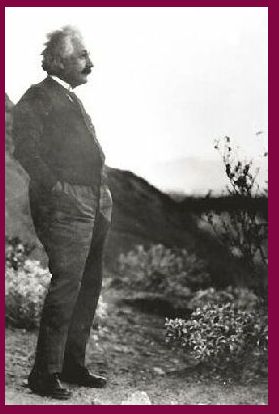 Lesson 3:
Lesson 3:
 The Essence of Life
The Essence of Life
|
 3.0
3.0
 Introduction and Overview
Introduction and Overview

|
 |
Figure 3.0.1
 Albert Einstein- His ideas changed
Albert Einstein- His ideas changed
the course
of modern physics and astronomy.
|
The 20th century was incredibly rich in scientific discoveries. Within
that century more people worked in science and more money was spent on
science than in all of the preceding human history. Among the great
discoveries of the past century are the following (make your own list
before reading on, and add the names associated with the discoveries):

|
Mass and energy are the same thing
|

|
Gravity is a deformation of space
|

|
Time and matter come in minimum quantities
|

|
The Milky Way is our galaxy seen edge-on
|

|
There are billions of other galaxies out there
|

|
Most of them are billions of light years away
|

|
The universe is expanding
|

|
The Sun is powered by fusion of hydrogen to helium
|

|
Elements are made inside stars, some during normal fusion, some when the star explodes
|

|
The Earth is 4.6 billion years old
|

|
Basic organic molecules are easily made from inorganic stuff
|

|
Life is more than 3.8 billion years old
|

|
Life is incredibly diverse, especially at the microbe level
|

|
Slime molds, trees, and people have much the same genetic material
|

|
The evolution of complex life forms is strongly influenced by mass extinctions
|
In addition to such discoveries (many of which obviously bear on the
likelihood of Life in the Universe; as you can easily verify, please)
there are equally impressive feats of engineering accomplishments. Here
are some of these:

|
Fast and efficient automobiles
|

|
Air travel, from propeller-driven planes to jet planes
|

|
Submarines
|

|
Rocket Propulsion
|

|
Nuclear fission (power generators and bombs)
|

|
Nuclear fusion (bombs only, so far)
|

|
An array of highly sophisticated drugs
|

|
Electric household devices, from refrigerators to microwave ovens
|

|
Telephone, radio, TV
|

|
Computers and computer programming
|
Two achievements stand out:
Scientific:
The galaxies around us, even though separated by
millions of light years, seem to have much the same types of stars as
our own, and appear to follow the same rules of physics and chemistry.
Thus, whatever we learn about physics and chemistry in our labs on Earth
and in our local solar system and our local galaxy appears applicable to
the universe as a whole. (If this were not so, we could not speculate at
all about conditions for life elsewhere.)
Technical:
We actually made it to the Moon and back. The people who
landed there brought back samples, demonstrating beyond a shadow of
doubt that the Moon is just another planet of sorts, with rocks not
unlike the most common rocks on Earth. This feat, in fact, is the first
time that earth-bound life invaded another celestial body, by design
(rather than by being splattered about through impact). The design came
from a highly evolved many-celled eucaryotic organism with a big brain.
But by far most of the organisms landing on the Moon (millions) were
micro-organisms on the skin and within the guts of the lunar explorers.
As far as our bacteria are concerned, we humans are a good way to get
around, like a ship well-stocked with supplies.
Eventually, the ships that bacteria built over geologic time and that
provide a sheltered environment and mobility, might seed other planets
with bacteria to prepare them for more extensive occupation at a later
stage. For example, it is possible that certain types of bacteria could
survive right now on one of the moons of Jupiter (Europa). We could, in
principle, decide that we wish to make sure there is Life on that body -
or every body in the solar system that is able to support life of a kind
evolved on Earth. This is a more likely scenario than moving some of the
most complex organisms (ourselves) into rather inhospitable
environments. Of course, we do not usually think of bacteria as "us."
However, there are good reasons why we should. As far as we can tell,
all living things on Earth are closely related, by common ancestry. This
is the chief reason they have no problem feeding on one another - each
can use the other's building materials.
|





















